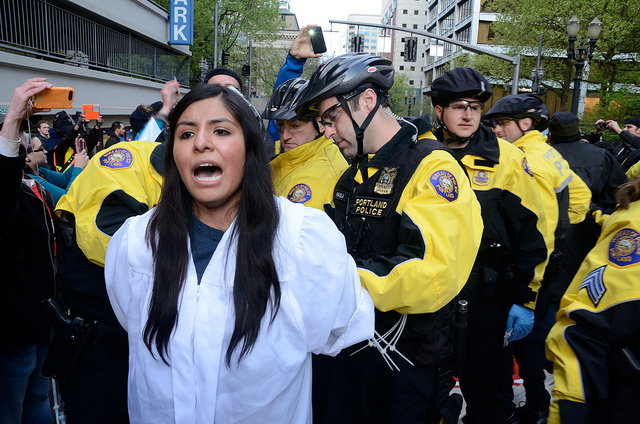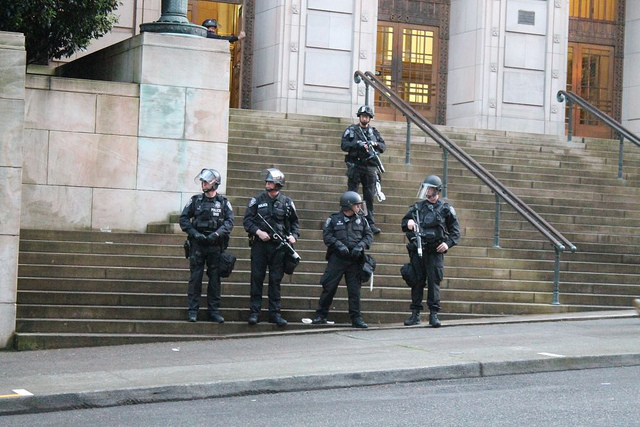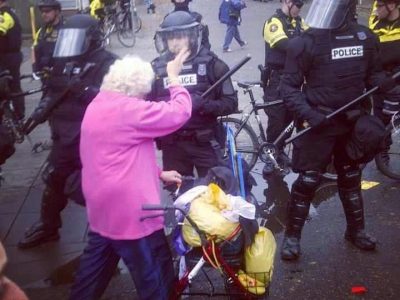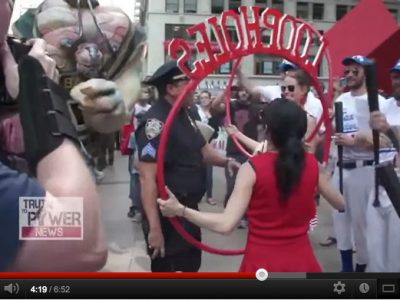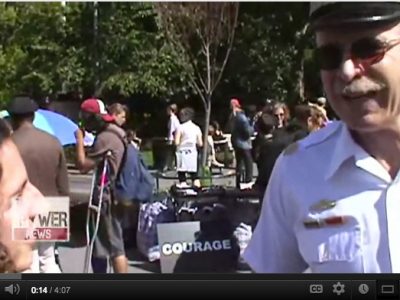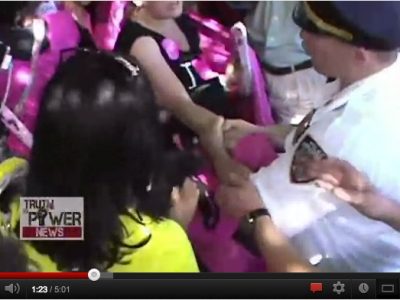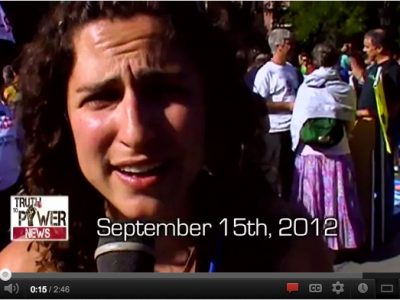This story is part of our feature about the many protest events on May 1, 2012. Visit the feature page to see more.
by Rochelle
The day began new–new blood infused into the Occupy Movement in the form of student protests outside of Portland Public School headquarters to highlight the financial inequities compromising youth education. Paul Wells, a 17-year-old Grant High junior and principal event organizer, said the striking students had assembled to stand in solidarity with international workers and students. “We’ve been facing austerity cuts for the last ten years,” said Wells, as he turned to his peers, lined up in front of a school district entrance, to lead the chant, “What do we do when our future is under attack? Stand up! Fight back!”
Madi Moskowitz, another Grant student organizer, said that although students arrived at 6:30 a.m. in an attempt to shut down the district workday, police beat them to the scene–taping off the perimeter of the property, but holding driveways open so district employees could get to work. “Some of those cars came within a hair of hitting kids,” said one dismayed Occupier. But Moskowitz was not disappointed, noting that the student effort had managed to set up large pickets on three sides of the PPS compound. “We really just want to educate people,” she said.
Approaching the yellow tape a little after 8 a.m., five district workers gestured at police flanking the student protesters. “How do we get in,” asked one, as an officer held up the tape and the group ducked under and scurried toward the main entrance. All avoided glancing at the protesters standing just inches away, and refused to comment.
Medha Pulla stood on one side of the protesters, holding a small sign that read, “Keep Tubman Open.” If the school district gets its way, Pulla will be in the final graduating class of the Harriet Tubman Leadership Academy for Young Women. On April 23, the Portland School Board announced that Tubman was on the chopping block and will close this May. Pulla, angered at the prospect of the school’s demise said, “We only had ten days to fight this. We don’t think this was fair–there was no community input.”
Since the closure was announced, Tubman–the only all-girls public school in Oregon–with an emphasis on math, science and leadership, has turned into a lightning rod for the community. Other statistics worth noting, according to Pulla: Only two percent of girls in co-ed schools go on to higher education in math and science, but at Tubman that number is over 50 percent. In addition, Tubman, whose minority enrollment also exceeds 50 percent, has halved its achievement gap in the last five years. Pulla believes the closure runs contrary to the Portland Plan, the centerpiece of which is equity.“We’re doing just what the city wants us to do,” said Pulla, “but they’re still closing us down.”
But Pulla holds out hope that the city may yet earmark a few dollars from its proposed budget (which goes to city council vote on May 16) to save her school. “We don’t think this is over,” she said.
At about 8:45 a.m., the students took to the street, marching to Tubman school, then downtown to Lincoln High. As a result, both Tubman and Lincoln were placed in lockdown. The march ended at City Hall, where Mayor Adams emerged to praise the student activism and offer use of the facilities.
[click here to read more about the Student Strike.]The next major action of the day was the return of a former homeowner to her house. Alicia Jackson, who was evicted post-foreclosure in August 2011, was given the key to her home, after a ribbon cutting ceremony witnessed by several hundred occupiers, who held the street in front of her northeast Portland house.
The event–a result of the efforts of ONE: The Black Working group, PLOC (Portland Liberation Organizing Council), and We Are Oregon, was hosted by Ahjamu Umi, a member of ONE, and Rain Crowe of PLOC. “This is the first time in Oregon that a community member is being moved back into her home,” said Rain. “Banks don’t need homes, people do.” Reflecting upon the fact that Jackson’s return to her home is just the beginning–“the next step is keeping her there”–Rain urged folks to follow the rapid response network set up to monitor Jackson’s situation. To join the effort, visit liberatepdx.org.
After Jackson gained reentry, a gardening swarm headed toward her backyard with soil, shovels, trees, and seedlings; another group carried Jackson’s furniture and possessions inside; some occupiers weeded the front garden beds, while a few people swept and pulled up carpet tacks inside the home. More people approached with food, as tables were set up and music was turned on for a block party celebration. “Figure out how you can help out,” coached Umi from the front porch. “Community engagement is how it is. That’s not how it’s going to look on the news, but that’s how it is. It’s community. That’s a beautiful thing. This is just day one of doing this kind of thing.”
[click here to read more about the PLOC action.]Marches–permitted and not–snaked and swirled through downtown Portland from early afternoon until well past dark. The first unpermitted march began at noon at the Burnside Bridge. The sky turned dark, showers fell, and several altercations ensued with the police–in other words, the usual unpredictable political protest in the City of Roses. A dozen protesters were arrested with filmed footage revealing rough treatment at the hands of the Portland Police Bureau, who displayed a marked bias against the day’s “unpermitted” actions.
[click here to read more about the police brutality.] [click here to read a different perspective on the General Strike march.]At 4:30 p.m. an estimated 2000 people took part in a permitted march that began in Shemanski Park. Police, who were much more unfriendly to the processions bookending the event, gently guided this march over a course that took two hours to complete.
In the early evening, a group unfurled a large banner from a parking garage opposite the Gus Solomon U.S. Courthouse. Many of those who had participated in the permitted march flowed toward the action, swelling up the steps of the courthouse, chanting, “Undocumented! Unafraid!” Behind the heavy glass doors of the courthouse, a half dozen riot cops stood at attention, while outside two young women, one in blue, the other in white graduation caps and gowns addressed the assembly. After giving their names, they each said, “I am undocumented and unafraid.” The crowd was visibly moved by the testimony of a number of undocumented speakers, who detailed the conditions of American life sans legal protections.
“I have been paying taxes and social security ever since I began working in this country,” said one woman. “But I have no rights. I cannot even drive my daughter to school, because I might be stopped, arrested and deported.”
The event culminated in the planned arrests–part of an ongoing national solidarity chain of action–of four undocumented protesters. As tears flowed around the circle, police cuffed the arrestees. The cap fell off the head of the young woman in royal blue graduation attire. Two police officers flanking her delicately struggled to replace the cap for nearly half a minute. With cap back on her crown, the woman was guided into a police car. While city attorney David Woboril looked on, police vehicles backed away from the crowd and turned toward the Justice Center, as the throng forcefully continued to chant “Undocumented! Unafraid!”
[click here to read more about the “Undocumented, Unafraid” activists, and hear their stories in their own words.]A dance party broke out on one end of the intersection, leading to a march that resulted in numerous confrontations with police and ended in a standoff with riot cops in front of the Justice Center just prior to 9 p.m. (By the next morning, the Portland Police Bureau announced there had been 36 arrests over the course of the day.) There was a sense of reunion and familiarity among many of the occupiers, who greeted one another and reminisced about the last time they stood at the edge of Chapman Square and faced off riot cops: It was eviction day–way back in November 2011. Protesters sang and howled at the top of their lungs to let their arrested comrades inside know they were not alone.
Monday night’s standoff lingers as a stark reminder that, while much new life stirred on a day that was promised as the reinvigoration of the Occupy movement, old worrying patterns persist–and some are escalating. A drive around downtown streets throughout the course of the day uncovered riot cops on many corners, horses around others and bike cop swarms seemingly everywhere. And there were far too many reports of protesters injured at the hands of Portland police.
[click here to read a response to the police.] [click here to read a response to the mayor and police officials.]Mayoral candidate Jefferson Smith, who appeared at the early afternoon unpermitted march in order to witness events of the day firsthand, said, “Everyone needs to be cool.” All the better if that’s an admonishment to police as well. Without a shift in old, heavy handed police tactics being lobbed at peaceful protest, there may be many difficult days ahead for those who take to the streets.



